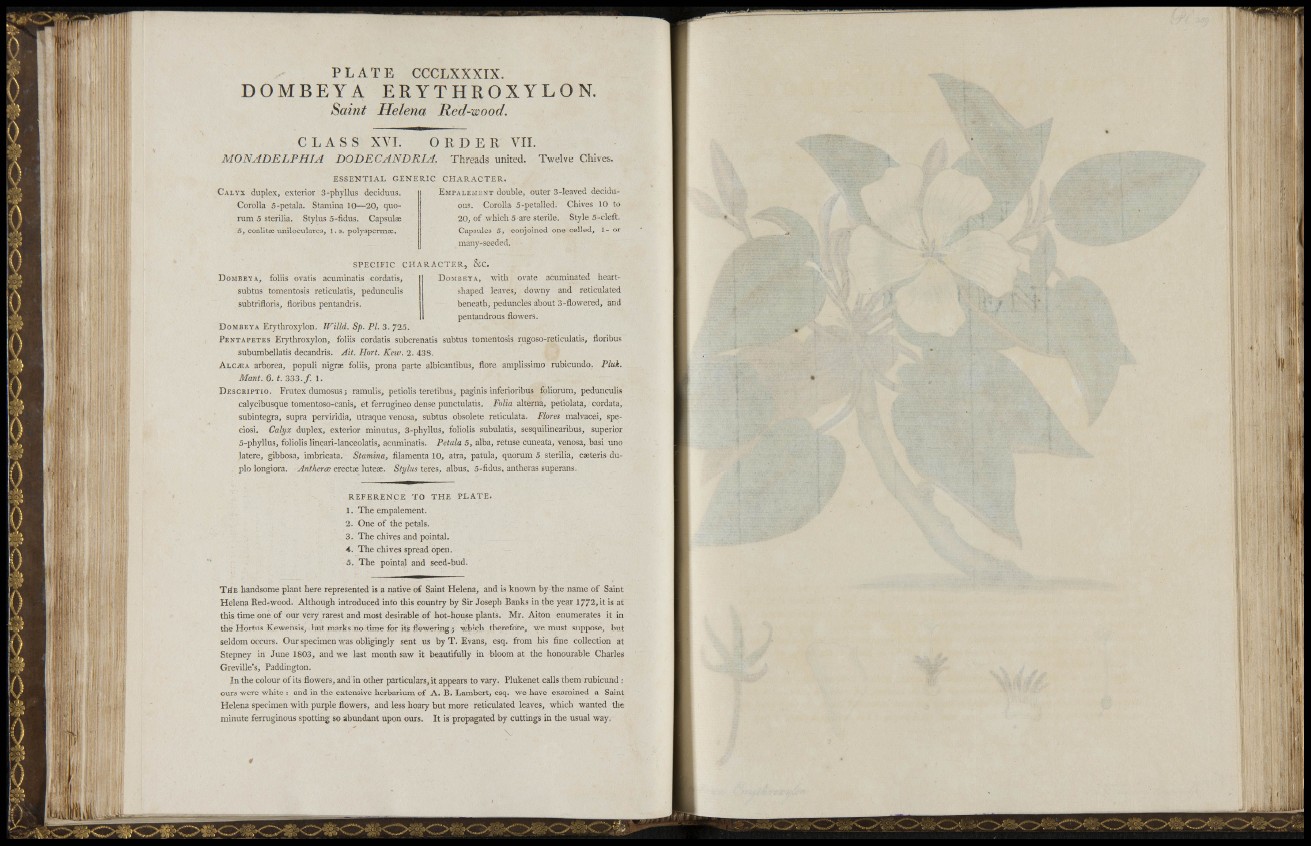
M
Ì
m- w
i
'i
I
I!,
11!i
i r ^ r
m
P L A T E CCCLXXXIX.
D O M B E Y A ERYTHROXYLON.
Saint Helena Red-wood.
C L A S S XVL O R D E R VII.
MONADELPHIA DODECANDRIA. Threads united. Twelve Chives.
E S S E N T I A L GENERIC CHARACTER.
CALYX duplex, exterior 3-phyllus deciduus.
Corolla 5-petala. Stamina 10—20, quorum
5 sterilia. Stylus 5-fidus. Capsulae
5, coalitee uniloculares, 1. s. polyspermce.
EMPALEMENT double, outer 3-leaved deciduous.
Corolla 5-petalled. Chives 10 to
20, of which 5 are sterile. Style 5-cleft.
Capsules 5, conjoined one-celled, 1- or
many-seeded. -
S P E C I F I C CHARACTER, &C.
DOMBEYA, foliis ovatis aeuminatis cordatis,
subtus tomentosis reticularis, pedunculis
subtrifloris^ floribus pentandi'is.
DOMBEYA, with ovate acuminated heartshaped
leaves, downy and reticulated
beneath, peduncles about 3-flowered, and
pentandrous flowers.
DOMBEYA Erythrosylon. IFilld. Sp. PL 3. 725.
P E N T A P E T E S Eiytliroxylon, foliis cordatis subcrenatis subtus tomentosis rugoso-reticulatis, floribus
subumbellatis decandris. jlit. Hoit. Kew. 2. 43S.
A L C J E A arborea, populi nigrae foliis, prona parte albicantibus, flore amplissimo rubicundo. Pluk.
Mant. 6. t. 333. / . 1.
DESCRIPTIO. Frutex dumosus ; ramulis, petiolis teretibus, paginis inferioribus foliorum, peduncuUs
calycibusque toraentoso-canis, et ferrugineo dense punctulatis. Fo/ia alterna, petiolata, cordata,
subintegra, supra perviridia, utraque venosa, subtus obsolete reticulata, Flores malvacei, speciosi.
Calyx duplex, exterior minutus, 3-phyllus, foliolis subulatis, sesquilinearibus, superior
5-phyllus, foliolis lineari-lanceolatis, aeuminatis. Fatala 5, alba, retuse cuneata, venosa, basi uno
latere, gibbosa, imbricata. Stamina, lilamenta 10, atra, patula, quorum 5 sterilia, caeteris duplo
longiora. ..^«i/icrce erectoe luteae. Stylus teres, albus, 5-fidus, antheras superans.
R E F E R E N C E TO THE PLATE.
1. The empalement.
2. One of the petals.
3. The chives and pointai.
4. The chives spread open.
5. The pointai and seed-bud.
TriE handsome plant here represented is a native of Saint Helena, and is known by the name of Saint
Helena Red-wood. Although introduced into diis country by Sir Joseph Banks in the year 1772, it is at
this time one of our very rarest and most desirable of hot-house plants. Mr. Aiton enumerates it in
the Hortus Kewensis, but marks no time for its flowering ; which therefore, we must suppose, but
seldom occurs. Our specimen was obligingly sent us by T . Evans, esq. from his fine collection at
Stepney in June 1803, and we last montli saw it beautifully in bloom at the honourable Charles
Greville's, Paddington.
In the colour of its flowers, and in other particulars, it appears to vary. Plukenet calls them rubicund :
oui-s were white : and in the extensive herbarium of A. B. Lambert, esq. we have examined a Saint
Helena specimen witli purple flowers, and less hoary but more reticvilated leaves, which wanted tlie
minute ferruginous spotting so abundant upon ours. It is propagated by cuttings in the usual way.
\